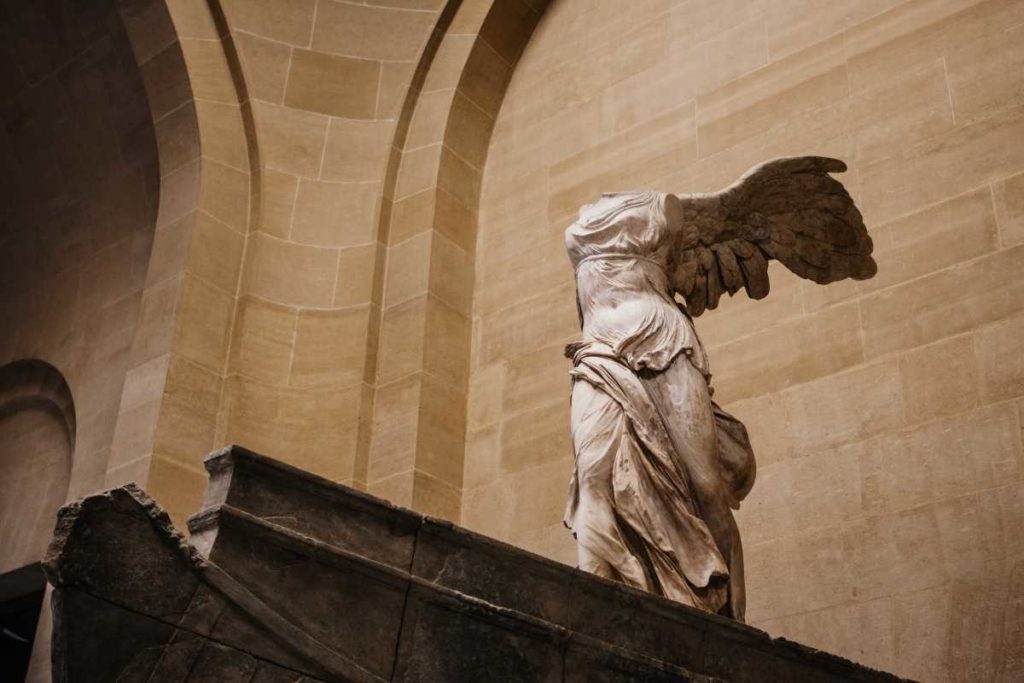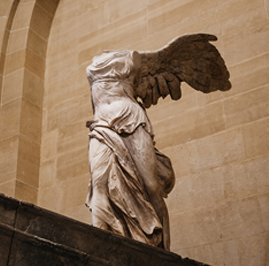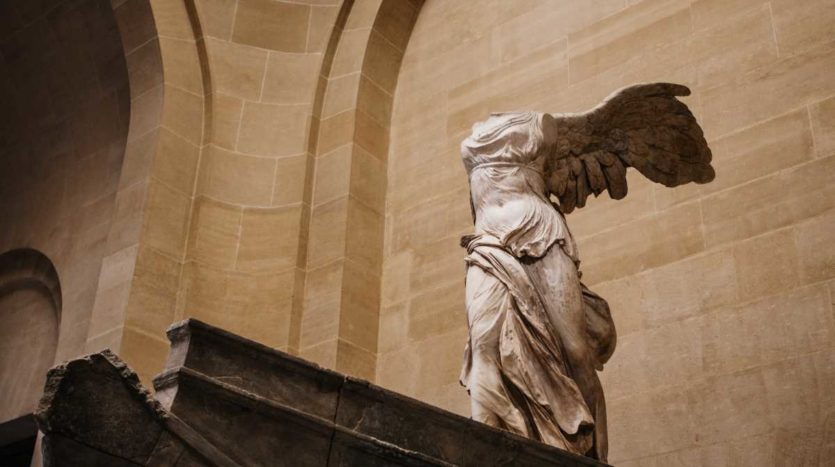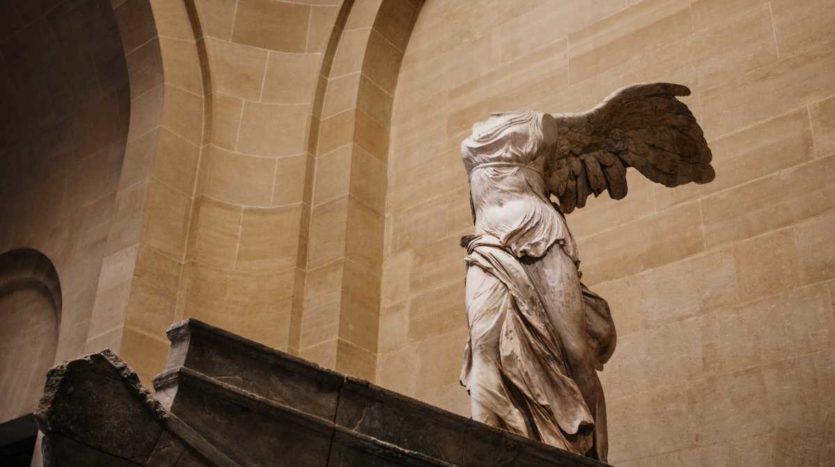The Winged Victory of Samothrace, The Largest Sculpture in The Louvre!
Visitors to the Louvre have been able to view an enormous sculpture of 2.75 meters, and even 5.12 meters if the whole structure is measured, at the top of the main staircase since 1884: it is the biggest sculpture on exhibit inside the museum. The Winged Victory of Samothrace, whose head and arms are missing, was found by Charles Champoiseau on the island of Samothrace in April 1863.
When Champoiseau told Napoleon III about his finding, he wrote to him, “Stone muslin.” The sculpture, which is of remarkable quality, emanates a sense of fervor and energy. It is a genuine antique masterpiece, with its plinth resembling the prow of a ship, evoking grandeur etched with strength and encouraging the spectator to dig into its past. So let’s get started!

The representation of a winged goddess
Nike, which means “victory,” was usually depicted as a winged lady in ancient times. She is clothed in a long tunic of delicate fabric with a flap folded beneath the breast and connected to the shoulders by two straps, and she is carved in white Paros marble. The left leg is exposed since the lower body is covered by a coat.
The many drapery elements, as well as the location of the mantle, which falls to the ground and runs over the back, indicate a wish to depict the wind – or the goddess’s movement. While with good reason: the goddess Nike’s right foot is just on the ground, and her left leg is still extended out in the air, indicating that she is about to land on the bow of the ship on which she is depicted. She isn’t walking; instead, she has just finished her flight. The arms are no longer there, but the elevated right shoulder indicates that the right arm was stretched or lifted to the side. There is no indication of the location of the left arm.
The overall idea most likely relates to giving gratitude to the Great Gods after a naval victory. The right arm may salute the audience, while the left arm could potentially carry a prize of naval triumph from the time: a stylis, or enemy ship’s mast.
The base is made of gray marble veined with white from the Lartos quarry in Rhodes. It is covered with a depiction of a battle bridge on which the statue sits, and it is shaped like a long, thin vessel with a spur. Oar boxes and two stacked oar seats may be seen on the sides.
A complex identification
The exact background of the Winged Victory of Samothrace’s construction is difficult to pinpoint: naval conflicts abound in this part of the globe in the 2nd and 3rd centuries BC. For control of the Aegean Sea, the Macedonians and Syrians fought up against the Egyptians and later the Rhodians.
If the date is still in doubt, a tetradrachm of the Macedonian commander Démétrios Poliorcète may provide a clue: the monument shown may very well be that of Samothrace. As a result, it’s possible that the fight in question is the one at Salamis, Cyprus, in which the Egyptian King Ptolemy I was defeated in 306 BC. J.-C.
According to German archaeologist Otto Benndorf, the Winged Victory of Samothrace would have been carved by a student of Scopas towards the end of the 4th century. This is just a theory, and many experts are dubious since no work of this scale has been discovered elsewhere. On the other hand, everyone agrees that the Winged Victory of Samothrace and the Pergamon altar in Dublin have a striking similarity, particularly in the technique of carving the bas-reliefs. The question remains unresolved since our sculpture has no apparent signature other than a scribbled fragment.
An emblematic place of worship in the Greek world
The Sanctuary of the Great Gods, one of the most important Pan-Hellenic sanctuaries on the island of Samothrace, is where the Winged Victory of Samothrace was discovered. Despite its proximity to the namesake city, it maintains its independence: ambassadors from the city have been sent there for major occasions.
The religion of Samothrace is well-known across Greece, and many notable people are initiated there, including Herodotus, the kings of Sparta, and prominent Athenians. It is also mentioned by Plato and Aristophanes in their writings.
The sanctuary predates the arrival of the Greeks on the island (in the 7th century BC), and the worshipped deities are mostly chthonic and clustered around a focal figure, the Great Mother – a lady shown with a lion by her side on Samothrace coinage. She’s been compared to the Mount Ida Trojan Mother Goddess and the Greek fertility goddess Hestia. The names of the deities present are kept a secret since it was prohibited in the secular world to speak them, and their nature is mostly unknown. Herodotus provided the name of the Great Mother: Axiéros, which stands for “La Digne.”
The Greeks linked other deities present with their own Gods in order to worship them in this specific location. As a result, Hecate and Aphrodite were separated from the religion of the Great Mother, which the Greeks worshipped, and given the name Zerynthia. Kadmylos, Axeros’s spouse, was absorbed into Hermes. He is joined by male demons known as the Cabires, who are said to be the forerunners of the mythical heroes who established the mysteries of Samothrace and later became known as the Dioscuri, guardians of seafarers to the Greeks. Finally, two underworld gods, Hades and Persephone, may not have been part of the ancient pre-Greek pantheon.
In this collection, the Winged Victory of Samothrace is a sacrifice given to the Great Gods in gratitude for a naval victory. If the provenance of the marble blocks that make up the ship’s bow are to be believed, the dedication is Rhodian rather than Macedonian.
The Winged Victory of Samothrace was recently restored in 2014, with the sculpture only being relocated a few tens of meters: it should be noted that the goddess and her base are constructed of no fewer than 200 marble blocks, weighing in at 29 tons! When you see it, the feeling remains, magnificently greeting visitors like pilgrims did in the past. See you there, sure to be amazed!




